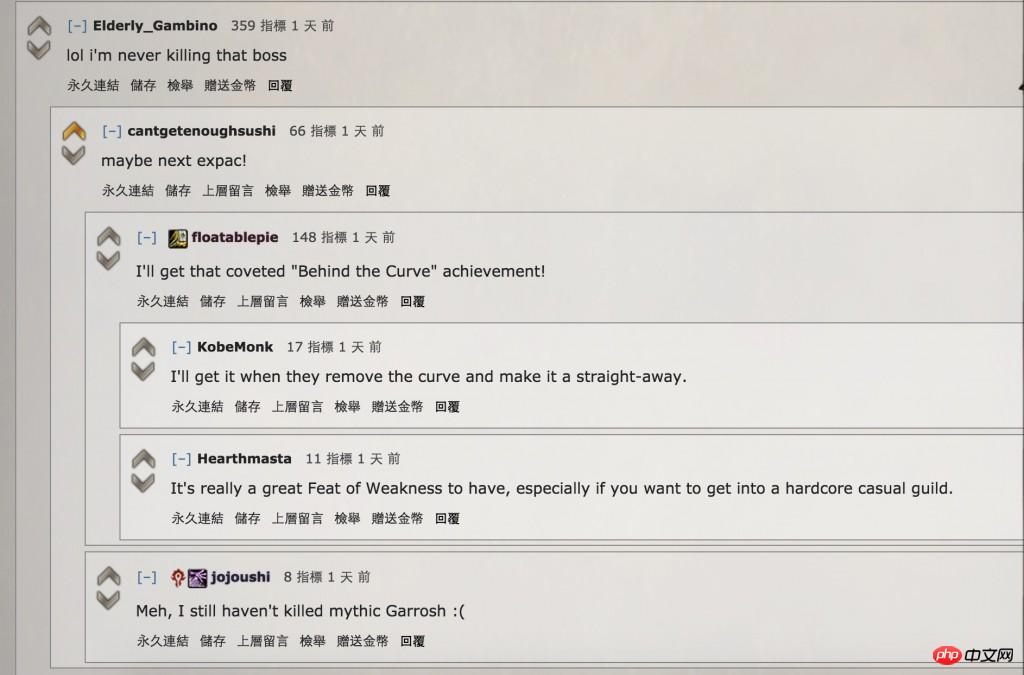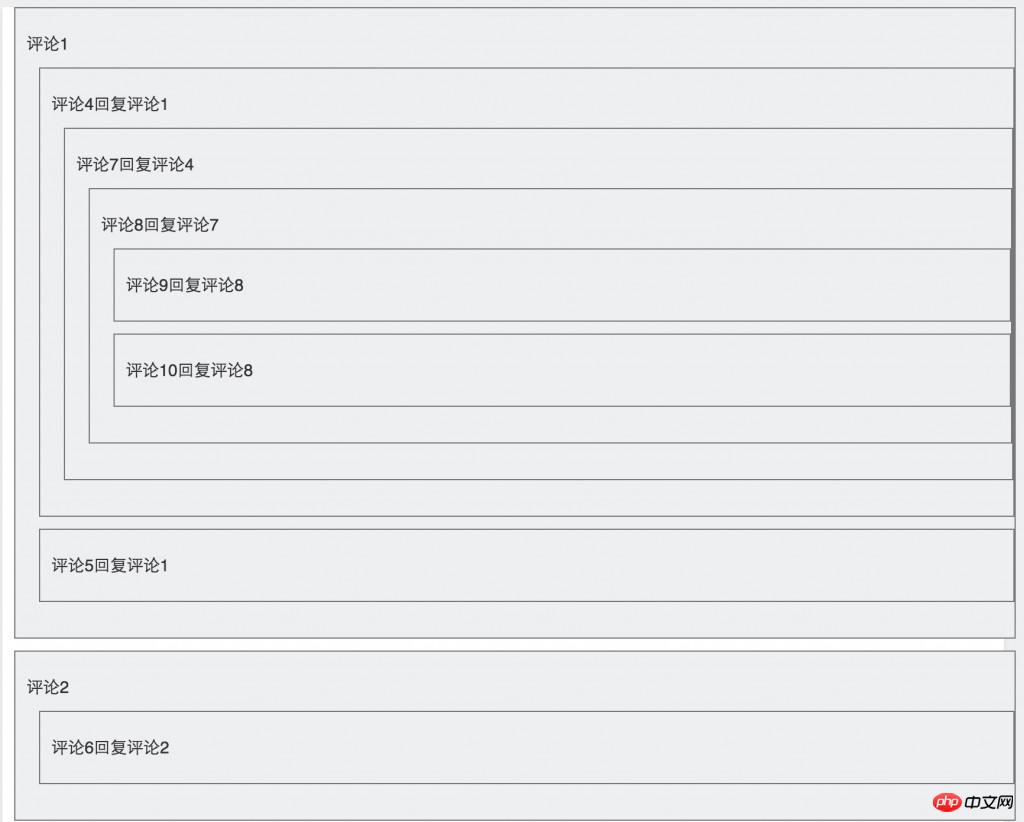PHP implements Changyan message board and NetEase post style
This article mainly introduces the implementation of Changyan message board and NetEase post style in PHP. Interested friends can refer to it. I hope it will be helpful to everyone.
Changing Message Board Style:

## NetEase Post Style:

PrincipleYou need to add two main fields, id and pid, to the comment table. Other fields can be added at will, such as Article id, reply time, reply content, reply person, etc.
The pid is the ID of the comment that has been replied to currently.
As you can see from the picture above, the pid of each layer is the id of the comment on the previous layer. Take a closer look at the layout above. Is it very similar to multidimensional arrays in PHP? If you can think of it, it's easy.
Implementation method1. Front desk: This is relatively simple, it is p embedded in p. Then set the border and margin padding of p
<p class="comment"> <p class="comment"> <p class="comment"> </p> </p> </p> <p class="comment"> </p>
2. Backstage: Two recursions are used. First, recursion is used to reorganize the results in the database. After reorganization, then use recursion to output the above front-end code. The structure and content of the comment table are as follows

Array ( [0] => Array ( [id] => 1 [pid] => [content] => 评论1 ) [1] => Array ( [id] => 2 [pid] => [content] => 评论2 ) [2] => Array ( [id] => 3 [pid] => [content] => 评论3 ) [3] => Array ( [id] => 4 [pid] => 1 [content] => 评论4回复评论1 ) [4] => Array ( [id] => 5 [pid] => 1 [content] => 评论5回复评论1 ) [5] => Array ( [id] => 6 [pid] => 2 [content] => 评论6回复评论2 ) [6] => Array ( [id] => 7 [pid] => 4 [content] => 评论7回复评论4 ) [7] => Array ( [id] => 8 [pid] => 7 [content] => 评论8回复评论7 ) [8] => Array ( [id] => 9 [pid] => 8 [content] => 评论9回复评论8 ) [9] => Array ( [id] => 10 [pid] => 8 [content] => 评论10回复评论8 ) )
where $array is the array read above. First, take out the pid, which is empty by default. Then recurse, after taking out the array whose pid is the current comment id
public static function tree($array,$child="child", $pid = null)
{
$temp = [];
foreach ($array as $v) {
if ($v['pid'] == $pid) {
$v[$child] = self::tree($array,$child,$v['id']);
$temp[] = $v;
}
}
return $temp;
}Array
(
[0] => Array
(
[id] => 1
[pid] =>
[content] => 评论1
[child] => Array
(
[0] => Array
(
[id] => 4
[pid] => 1
[content] => 评论4回复评论1
[child] => Array
(
[0] => Array
(
[id] => 7
[pid] => 4
[content] => 评论7回复评论4
[child] => Array
(
[0] => Array
(
[id] => 8
[pid] => 7
[content] => 评论8回复评论7
[child] => Array
(
[0] => Array
(
[id] => 9
[pid] => 8
[content] => 评论9回复评论8
[child] => Array
(
)
)
[1] => Array
(
[id] => 10
[pid] => 8
[content] => 评论10回复评论8
[child] => Array
(
)
)
)
)
)
)
)
)
[1] => Array
(
[id] => 5
[pid] => 1
[content] => 评论5回复评论1
[child] => Array
(
)
)
)
)
[1] => Array
(
[id] => 2
[pid] =>
[content] => 评论2
[child] => Array
(
[0] => Array
(
[id] => 6
[pid] => 2
[content] => 评论6回复评论2
[child] => Array
(
)
)
)
)
[2] => Array
(
[id] => 3
[pid] =>
[content] => 评论3
[child] => Array
(
)
)
)public static function traverseArray($array)
{
foreach ($array as $v) {
echo "<p class='comment' style='width: 100%;margin: 10px;background: #EDEFF0;padding: 20px 10px;border: 1px solid #777;'>";
echo $v['content'];
if ($v['child']) {
self::traverseArray($v['child']);
}
echo "</p>";
}
}
The role of php anonymous functions and closures
PHP method of sorting two-dimensional arrays
How to set header information in PHP
The above is the detailed content of PHP implements Changyan message board and NetEase post style. For more information, please follow other related articles on the PHP Chinese website!

Hot AI Tools

Undresser.AI Undress
AI-powered app for creating realistic nude photos

AI Clothes Remover
Online AI tool for removing clothes from photos.

Undress AI Tool
Undress images for free

Clothoff.io
AI clothes remover

AI Hentai Generator
Generate AI Hentai for free.

Hot Article

Hot Tools

Notepad++7.3.1
Easy-to-use and free code editor

SublimeText3 Chinese version
Chinese version, very easy to use

Zend Studio 13.0.1
Powerful PHP integrated development environment

Dreamweaver CS6
Visual web development tools

SublimeText3 Mac version
God-level code editing software (SublimeText3)

Hot Topics
 11 Best PHP URL Shortener Scripts (Free and Premium)
Mar 03, 2025 am 10:49 AM
11 Best PHP URL Shortener Scripts (Free and Premium)
Mar 03, 2025 am 10:49 AM
Long URLs, often cluttered with keywords and tracking parameters, can deter visitors. A URL shortening script offers a solution, creating concise links ideal for social media and other platforms. These scripts are valuable for individual websites a
 Introduction to the Instagram API
Mar 02, 2025 am 09:32 AM
Introduction to the Instagram API
Mar 02, 2025 am 09:32 AM
Following its high-profile acquisition by Facebook in 2012, Instagram adopted two sets of APIs for third-party use. These are the Instagram Graph API and the Instagram Basic Display API.As a developer building an app that requires information from a
 Working with Flash Session Data in Laravel
Mar 12, 2025 pm 05:08 PM
Working with Flash Session Data in Laravel
Mar 12, 2025 pm 05:08 PM
Laravel simplifies handling temporary session data using its intuitive flash methods. This is perfect for displaying brief messages, alerts, or notifications within your application. Data persists only for the subsequent request by default: $request-
 Build a React App With a Laravel Back End: Part 2, React
Mar 04, 2025 am 09:33 AM
Build a React App With a Laravel Back End: Part 2, React
Mar 04, 2025 am 09:33 AM
This is the second and final part of the series on building a React application with a Laravel back-end. In the first part of the series, we created a RESTful API using Laravel for a basic product-listing application. In this tutorial, we will be dev
 Simplified HTTP Response Mocking in Laravel Tests
Mar 12, 2025 pm 05:09 PM
Simplified HTTP Response Mocking in Laravel Tests
Mar 12, 2025 pm 05:09 PM
Laravel provides concise HTTP response simulation syntax, simplifying HTTP interaction testing. This approach significantly reduces code redundancy while making your test simulation more intuitive. The basic implementation provides a variety of response type shortcuts: use Illuminate\Support\Facades\Http; Http::fake([ 'google.com' => 'Hello World', 'github.com' => ['foo' => 'bar'], 'forge.laravel.com' =>
 cURL in PHP: How to Use the PHP cURL Extension in REST APIs
Mar 14, 2025 am 11:42 AM
cURL in PHP: How to Use the PHP cURL Extension in REST APIs
Mar 14, 2025 am 11:42 AM
The PHP Client URL (cURL) extension is a powerful tool for developers, enabling seamless interaction with remote servers and REST APIs. By leveraging libcurl, a well-respected multi-protocol file transfer library, PHP cURL facilitates efficient execution of various network protocols, including HTTP, HTTPS, and FTP. This extension offers granular control over HTTP requests, supports multiple concurrent operations, and provides built-in security features.
 12 Best PHP Chat Scripts on CodeCanyon
Mar 13, 2025 pm 12:08 PM
12 Best PHP Chat Scripts on CodeCanyon
Mar 13, 2025 pm 12:08 PM
Do you want to provide real-time, instant solutions to your customers' most pressing problems? Live chat lets you have real-time conversations with customers and resolve their problems instantly. It allows you to provide faster service to your custom
 Announcement of 2025 PHP Situation Survey
Mar 03, 2025 pm 04:20 PM
Announcement of 2025 PHP Situation Survey
Mar 03, 2025 pm 04:20 PM
The 2025 PHP Landscape Survey investigates current PHP development trends. It explores framework usage, deployment methods, and challenges, aiming to provide insights for developers and businesses. The survey anticipates growth in modern PHP versio






